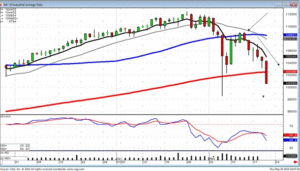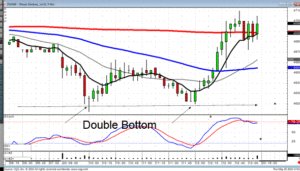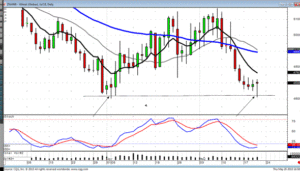The legal way of scalping commodity profits is to look for many small gains during the trading day. In scalping commodity profits traders can make money in either a moving or a quiet commodity market. Simply using the bid/ask spread the trader can make money always buying at the bid price and selling at the ask price in a quiet market. This is also known as spread trading. When the market moves the trader will buy and sell taking small profits throughout the day. Because the market will fluctuate as it moves the scalper will also take losses. Because there is a cost of trading, commissions and fees, it is important for the trader to keep close track of his or her trades to make sure that the overhead of scalping commodity profits does not eat up all profits. A good way to understand scalping in the commodities markets or elsewhere is to take commodity and futures training. The ability to predict market movement with technical analysis tools such as Candlestick chart analysis and Candlestick trading tactics will help the trader in scalping for profits.
The three basic tenets of scalping commodity profits or scalping in any market are these. The shorter the time you are in the market the less your risk. Small moves in the market are more common than larger ones. The nature of the market is that smaller moves are tied to trading whereas larger moves require a change in market fundamentals. Whether the trader is essentially doing arbitrage on small gaps created by the bid ask spread or taking advantage of the irregularity of a market advance, he or she will rely upon technical analysis to make profits. This is not a world of fundamental analysis of commodity futures or commodity options. It is the very attentive watching of the commodities market and the taking of small profits when they are available. This is a very business like approach to trading that can make money every day.
Something important to remember is that the other meaning of scalping is illegal market manipulation. This kind of scalping is when an broker or other insider purchases a security for his or her own account and then promptly recommends it for long term investment. When the equity price goes up the scalper immediately sells and pockets the profit. This is illegal and, when found out, is prosecuted by the SEC. On the contrary scalping by taking advantage of changes in market liquidity, market direction, and progressively widening bid ask prices as the market will allow is perfectly legal and potentially very profitable. The use of Candlestick basics to help determine the direction of individual commodities is essential in the process of scalping commodity profits.
A nice aspect in trading commodities by scalping is that the trader does not have to wait for a major movement in the market as might be the case with trading options in the commodity market or stock market. As it is just a possible to scalp for profits in a quiet market as a moving market the trader can take a lunch break without fearing that he or she will miss a great commodity market opportunity. A degree of market inefficiency is embedded in the bid ask spread. For many traders with the patience and diligence required, this is enough to profit nicely in scalping commodity profits. Trading mini waves in the market that last less than a minute the commodity trader can take advantage of brief commodity prices changes before they disappear. By staying in the market ever so briefly this sort of trading, of course, requires a familiarity with commodity trading software to keep up the minute if not the second.
Market Direction
Why were we able to make big profits this past week on the short side? Having the knowledge of how price patterns perform! The Dow has formed a Blue Ice Failure pattern. This pattern was named by Dave Elliott of Wall Street teachers. ( We will try to get him back on a Thursday night chat very soon ) a blue ice failure pattern has very simple parameters. Once a price comes down through a potential support level, the price will try to come back up through that support level. If it fails, it will go down to the next support level. This was evident when we saw a Bearish Harami in the Dow, forming at the 50 day moving average. That became an indicator to start shorting with confidence.
Many investors have problems with when to enter a trade as well as when to take profits. If the analysis of a pattern can easily project the next viable target, that should be a place to take profits. That does not necessarily mean completely closing out a portfolio but at least taking part of the positions off at those levels. Why is that? If a pattern has a projected target, such as witnessed in the Blue Ice Failure of the Dow, that means the target has been hit enough times in the past to make it a very high probability level to be watched. If that is the case, once that target is reached, there will be the probabilities of people taking profits. Take some profits yourself. However, be aware of what type of signal is forming at that support level. As demonstrated in today’s trading, the Dow did not slow down at the 200 day moving average, it went right through. This makes the remaining portfolio still short but now looking for the next potential reversal area. 
DOW
If there is not a another identifiable support level, what becomes the next criteria for when to close out short positions? The next candlestick reversal signal. Obviously the price trend will be in the oversold condition. Learning candlestick reversal signal appears, that is an indication the Bulls are starting to step in. This could be a good distance below the previous support level. That now makes that support level, in this case the 200 day moving average, the next upward target. Cover the short positions, go long but then watch to see what happens when everything comes back up to test that most recent support level.
When to take profits and when to honor your stop loss levels. That is a very difficult procedure for most investors. Emotions get intertwined very quickly. Take profits when the probabilities indicate it is time to take profits. We were short July wheat. There were a couple of days of indecisive trading. Today, wheat traded lower in sympathy with the equity markets. It was a good time to take profits when the price got back to the same levels it bottomed out previously.

July Wheat 5 min. Chart
It is the ability to visually recognize what is occurring at previous price points that greatly eliminates the emotions out of trading. This is especially true when trading commodities. Once you have learned how to master your emotions trading commodities, you can trade any market after that. Candlestick signals and patterns have simple trading rules. Those rules were established to take advantage of high probability situations. Once you can utilize the information built into candlestick signals, you would then be able to trade without fear and panic.
Commodity traders – do not miss this weekend’s Candlestick Forum Commodity Trading training – you will discover how to take the fear of volatile trading entities out of your thought process. Understanding how commodities move not only becomes an asset for trading them successfully, you also gain valuable evaluation information when trading commodity-based stocks. This is not rocket science! This is commonsense investment practices applied to trading entities that move with much more profitability with the same human emotions pushing the prices around. Please take time to look at trading commodities. It is knowledge that you will utilize for all aspects of investing successfully. Click here for more information.
Chat session tonight at 8 PM ET
The Candlestick Forum Team
2-Day-Commodity Training
Webinar May 22-23, 2010
Website special reflects current newsletter. If you are reading an archived newsletter you will be directed to the Current Website Special.

Speak Your Mind